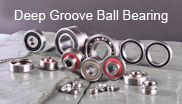Dear Visitors We will attend in 2014 CHINA INTERNATIONAL BEARING INDUSTRY EXHIBITION, taking place on 18 Sep, 2014 to 21 Sep, 2014, in SHANGHAI WORLD EXPO EXHIBITION & CONVENTION CENTER. Our Hall Number is: H2, Booth Number is: G128 Thanking you!
Thank you.

Properties of Bearing Steel
machine parts that may get subjected to high fatigue and stress conditions. These bearings facilitate in effectively transmitting dynamic loads within the machine body as well as help in reducing friction between the moving parts, thereby ensuring a smooth motion. Bearings could be of various types such as ball bearings, tapered, cylindrical and needle roller bearings. Bearings are manufactured using a grade of steel called bearing steel that has mechanical properties which are more suited for lowering the friction levels. Hydraulic Motor , Hydraulic Motors , Hydraulic Winch , Planetary Gearbox
Chemical Composition
Bearing steel has carbon content in the range of 0.55 to 1.10 percent, manganese in the range of 0.10 to 1.15 percent, silicon in the range of 0.15 to 2.0 percent, phosphorus and sulfur up to a maximum of 0.03 percent and chromium in the range of 0.5 to 2.0 percent. The remaining percent is iron. Chemical properties determine the anti-corrosive properties of the bearing steel. The chemical composition of the steel also dictates its mechanical and physical properties such as the strength and hardness, toughness and brittleness and ductility and malleability.
Hardness
Bearing steel has enormous hardness because the manufacturing process of bearing steel requires melting and degassing of the metal followed by certain metallurgical processes. It is then tempered and quenched. Bearing steel has a bending strength of 2400 MPa (Pascal Unit) and can withstand high stress and centrifugal forces. But it has a low corrosion resistance. Bearings materials can either be through-hardened or case-hardened and may also require vacuum-processing to ensure purity. A minimum expected hardness for bearing components is 58 Rc (measurement of hardness) but it has generally higher hardness levels.
Strength
Carbon increases the strength of bearing steel. Strength ensures that parts (i.e., bearings) made from it do not deform on the application of stress and load. Ductility and weldability, however, decrease with increasing carbon content. In addition to this, bearing steel is designed to have high fatigue strength and life and needs to respond uniformly to the heat treatment process. It should have a compact structure with a consistent grain flow and a fine grain size that imparts high impact toughness to the alloy.
Physical Properties
Bearing steel has a density of 7.85 gm per cubic-cm, coefficient of linear expansion (i.e., the change in length per unit length resulting from a 1 degree rise in temperature) of 0.00001 per K and thermal conductivity of 30-40 W mK. Bearing steel is magnetic in nature and is a good thermal and electrical conductor.



